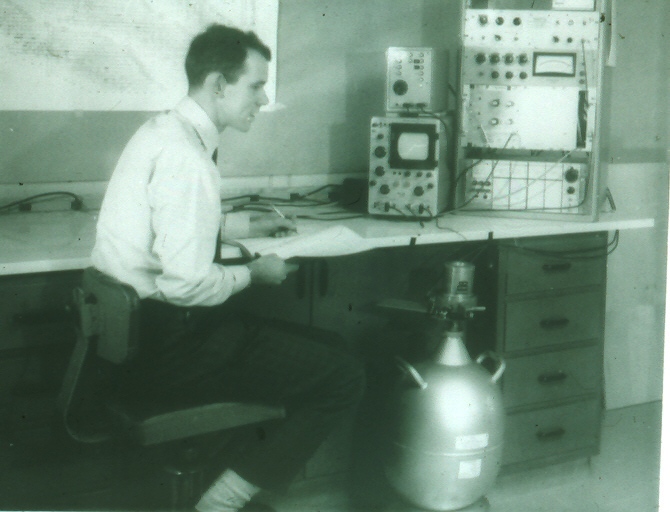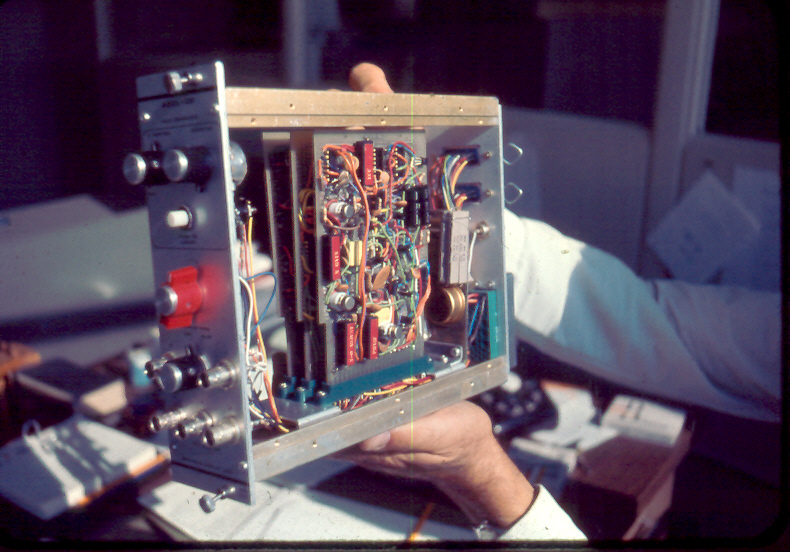








Early uses of computers in gamma ray spectral analysis
1. Bristow Q, and Thompson C J: "A computer PHA system for real time off-line analysis of spectra from an aerial survey for radioactive minerals." IEEE Trans Nucl Sci NS-14 150-156 (1968)
2. Thompson C J: "Activation analysis with an on-line PDP-9 computer". Nuclear Applications 6: 559-566 (1969)
3. Tolmie R W and Thompson C J: "Mobile equipment for combined neutron activation and X-ray fluorescence analysis". Proc IAEA Symposium on Nuclear Techniques for Mineral Exploration and Exploitation. Cracow, Poland,1969. IAEA Vienna, 7-26 (1971)
4. Thompson C J: "Computer techniques in neutron activation analysis". Proc IAEA Symposium on Nuclear Techniques for Mineral Exploration and Exploitation. Cracow, Poland, December 8-12, 1969. IAEA (Vienna), 115-128 (1971)
 |
 |
 |
| This is the Atomic Energy of Canada Ltd. building in Ottawa where I worked from 1996 to 1970. It is located in a complex of government buildings known as "Tunney's Pasture" on the Ottawa river a few km. West of the parliament buildings. At the time I started, the instrumentation development group in which I worked purchased a "PDP-9" computer, and I learned to program it. This photo was taken in 1966 | Most of my work was related to the measurement of gamma ray spectra from mineral samples which were activated with an antimony-beryllium neutron source. This picture shows one of the detectors which was cooled in liquid nitrogen. The cryostats required weekly addition of liquid nitrogen, and were placed on bathroom scales to ensure that there was enough to keep them cool. Photo from 1967. | During the four years I worked there I was very much involved with the programming of the PDP-9 computer to acquire and analyze the gamma-ray spectra. I designed the display and ADC interfaces. The left-most cabinet contained the core-memory (about 64 Kbytes). There was no disk, but programs and data were stored on the block-addressable "DEC-Tapes" Photo from 1969 |
 |
 |
 |
| The computer had no display, so I designed this NIM module which was interfaced to the computer to provide an interactive display of the spectra. One on the black knobs moved caused one selected dot to become a circle. This allowed the user to identify one point on the spectrum and the white button was pressed to identify this point to the computer, much the same way as a mouse is used today. | This picture was taken from the oscilloscope which displayed the spectra. The two circles (or "halos" as we called them) were placed manually to identify the base of the spectra, and the computer printed out the area under the peak after subtracting the background. Later, the peaks were identified automatically from a library; and from the activation, delay and counting times the mass of the element calculated. | This plot of gamma-ray spectra from a mixture of gold and silver illustrates the improved energy resolution (below) possible with the cooled germanium detectors compared with the sodium iodide crystal (above) which were used prior to the development to germanium detectors. The detectors were made by RCA in Montreal. |
 |
 |
 |
| Another major project during my time in Ottawa was the development of aerial surveying for radioactive minerals. I was involved in the original feasibility study during which we hovered over known deposits of uranium in a helicopter and to record the gamma-ray spectra and compared our results with a very detailed ground survey of the same area. | This picture shows the instruments in the cargo bay of the helicopter. It was very noisy and hot work as the gear-box for the drive-shaft for the rear rotor was right above where we sat during the flights. The tests were conducted near Elliot Lake in Northern Ontario. | This project paved the way for the construction of a much bigger detector array which could be flown in a small aircraft which was used to make a gamma-ray survey of much of Canada by the Geological Survey of Canada. The bigger detector volume allowed the aircraft to fly much faster and higher than the helicopter used in the trial. |